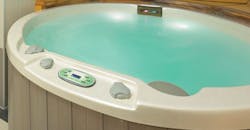NEC Rules for Pools, Tubs, Fountains, and Spas ― Part 4
Article 680, Part IV provides the requirements for electrical equipment associated with spas and hot tubs. This may seem redundant with Part III (storable pools, spas, and hot tubs), but it isn't.
Some highlights:
- You must install a clearly marked, readily accessible emergency switch within 5 ft of the spa/tub and within sight of it [Sec. 680.41]. This isn't required for one-family dwellings but consider including it.
- Indoor and outdoor installations must also comply with Parts I and II of Art. 680.
- For outdoor installations, you can bond on a common metal base or frame [Sec. 680.42(B)].
- For indoor installations, you must supply at least one 125V, 15A or 20A receptacle at 6 to 10 ft from the inside wall of the spa/tub [Sec. 680.43(A)].
- Receptacles must be GFCI protected [Sec. 680.43(A)(2) and (3)].
- Lights and fans installed over an indoor spa/tub must be mounted at a minimum of 12 ft if not GFCI-protected. If GFCI-protected, the height requirement is reduced to 7 ft, 6 in. [Sec. 680.43(B)(1)].
- The height limit is waived if either condition in Sec. 680.43(B)(1)(c)(1) or (2) is met.
About the Author

Mark Lamendola
Mark is an expert in maintenance management, having racked up an impressive track record during his time working in the field. He also has extensive knowledge of, and practical expertise with, the National Electrical Code (NEC). Through his consulting business, he provides articles and training materials on electrical topics, specializing in making difficult subjects easy to understand and focusing on the practical aspects of electrical work.
Prior to starting his own business, Mark served as the Technical Editor on EC&M for six years, worked three years in nuclear maintenance, six years as a contract project engineer/project manager, three years as a systems engineer, and three years in plant maintenance management.
Mark earned an AAS degree from Rock Valley College, a BSEET from Columbia Pacific University, and an MBA from Lake Erie College. He’s also completed several related certifications over the years and even was formerly licensed as a Master Electrician. He is a Senior Member of the IEEE and past Chairman of the Kansas City Chapters of both the IEEE and the IEEE Computer Society. Mark also served as the program director for, a board member of, and webmaster of, the Midwest Chapter of the 7x24 Exchange. He has also held memberships with the following organizations: NETA, NFPA, International Association of Webmasters, and Institute of Certified Professional Managers.
